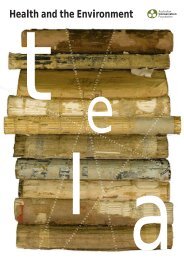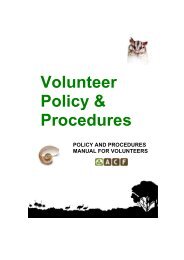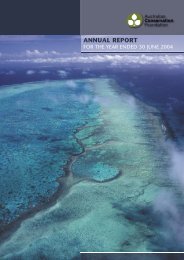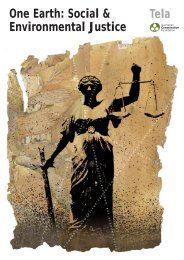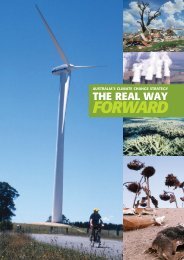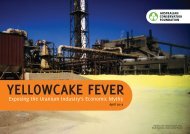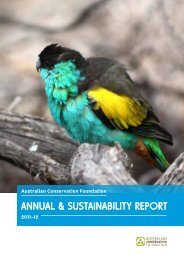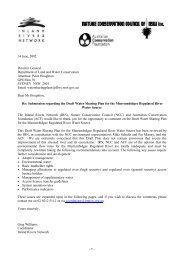Protecting Western Australia's Big Blue Backyard - The Pew ...
Protecting Western Australia's Big Blue Backyard - The Pew ...
Protecting Western Australia's Big Blue Backyard - The Pew ...
- No tags were found...
Create successful ePaper yourself
Turn your PDF publications into a flip-book with our unique Google optimized e-Paper software.
2EXECUTIVE SUMMARY<strong>Protecting</strong> <strong>Western</strong> Australia’s big blue backyardis the first report by Save our Marine Life,a new collaboration of global, national andstate-based environment organisations thatis built around a common vision to conserveAustralia’s unique marine life through workingwith local communities, governments, industrystakeholders and Traditional Owners to securea Comprehensive, Adequate and Representative(CAR) network of large no-take reserves inAustralia’s marine environment.A Comprehensive conservation reserve networkis one in which all major bioregions havereserves within them. Adequate refers to thenumber, size, configuration and levelof protection of the reserves within a bioregion.<strong>The</strong> reserves also need to be Representativeof the ecosystems within the bioregions.<strong>The</strong> Conservation Council of <strong>Western</strong> Australia,the Australian Conservation Foundation,<strong>The</strong> Wilderness Society, WWF-Australia,the Australian Marine Conservation Society,<strong>The</strong> Nature Conservancy and the <strong>Pew</strong>Environment Group have established theSave our Marine Life Collaboration.<strong>The</strong> area of focus for the Collaboration’s firstreport, <strong>Protecting</strong> <strong>Western</strong> Australia’s bigblue backyard, is the southern half of <strong>Western</strong>Australia’s immense coastline, from Kalbarri toEucla. This is the <strong>Western</strong> Australian componentof the South-west Marine Region currently beingconsidered for protection by the AustralianGovernment under its National RepresentativeSystem of Marine Protected Areas.<strong>The</strong> marine environment from Kalbarri to Euclais globally significant for its unique and threatenedspecies, underwater features and ecosystemsincluding:– globally high levels of unique marine species(70–90 per cent found nowhere else on Earth)as a result of geological isolation, an unusualmajor southerly current bringing temperateand tropical species together, and a historyfree of major environmental disturbance ingeological time– a series of hotspots for marine life including theHoutman-Abrolhos Islands, the Perth Canyon,Geographe Bay, Cape Mentelle, the NaturalistePlateau, the Diamantina Fracture Zone, theAlbany Canyons and the Recherche Archipelago– critical habitat for a range of significant speciesincluding the world’s largest animal, theendangered blue whale. Perth Canyon is one ofonly two blue whale feeding grounds known inAustralia. It is a key to the survival and recoveryof blue whales– one of the world’s largest sharks, the threatenedwhite shark; and the world’s largest marine turtle,the endangered leatherback turtle– a greater southerly range for major tropical coralreefs than anywhere else in the Indian Ocean– an unusual collection of fish life and habitatsas a result of low nutrients, clear water due tolimited river runoff, and waters warmer than arenormally found so far south– geologically and ecologically significantsubsea features including the deepest pointin Australia’s oceans, an island under thesea—a large submerged fragment of continentalshelf—Australia’s highest underwater mountainrange, and Australia’s largest marine canyon.A highly unusual and globally significant currentis the life force of this region. At 5500 kilometresin length, the Leeuwin Current is the world’slongest continuous coastal current, and its journeyalong the <strong>Western</strong> Australian coast connectsand supports the key elements of the protectionblueprint outlined in this report.With less than five per cent of the region’s marineenvironment explored, the region is in the midstof an exciting new phase of scientific discovery,with vast numbers of new species being foundwith each research voyage.<strong>The</strong> region’s unusual ecological characteristicsmake it both vulnerable to climate changeand important as a potential source of refugiafor species. <strong>The</strong>se include tropical corals andassociated marine life with ranges that may shiftsouth in the face of climate change that warmstheir existing habitats to the north.Of all Australian states, <strong>Western</strong> Australiais particularly dependent on its vast marineenvironment. <strong>The</strong> marine life of the Kalbarrito Eucla region has underpinned the State’ssocial, cultural and economic development andwill continue to be relied upon into the future.Marine-based recreation, tourism and tradeare significant economic drivers. Australia’s mostlucrative fishery, the western rock lobster fishery,is found in this region, and the oil and gasindustry appears to be on the cusp of asignificant expansion.With 90 per cent of the world’s large predatory fishalready gone, no nation can be complacent aboutits use of living marine resources. Commercialand recreational fishing in this region is placingenormous pressure on popular fish species.Monitoring in many no-take areas around theworld has shown fish abundance is higher inno-take reserves than in areas that continue tobe fished. Research by the Australian Instituteof Marine Science and James Cook Universityconfirmed this for the Great Barrier Reef MarinePark in 2008. <strong>The</strong> coral trout, for example,has been found to be twice as abundant insome of the no-take zones as it is in fished areas.Despite the critical importance of the region to<strong>Western</strong> Australia and the nation, its unique andrelatively intact nature, and the increasing impactsand threats from use, levels of protection areinadequate. Less than one per cent of the regionis secured in any type of marine protected area.This is in contrast to the protection afforded theeastern seaboard of Australia and Australia’sglobal commitment to manage and conserve thehuge marine environment in its care.Australia values highly its international leadershipposition in the conservation of marine life andhabitats. This is demonstrated by our commitmentto the Convention on Biological Diversity andother important international conventions.In order to maintain that standing, Australia’schallenge is to implement the expert internationalrecommendation that all nations establishnetworks of no-take areas covering at least20–30 per cent of each marine habitat. As littleas four per cent of Australia’s marine environmentis afforded no-take protection.Recent polling shows that <strong>Western</strong> Australiansview marine protection as highly important.Of those polled, 73 per cent saw marine protectionas very important, 75 per cent felt there was notenough marine protection in WA, and almost50 per cent called for protection to cover at least30 per cent of the marine environment.<strong>Protecting</strong> <strong>Western</strong> Australia’s big blue backyardconcludes that a CAR network of large no-takemarine reserves is needed now to secure the futureof marine life, industries and people in the Kalbarrito Eucla region. Non-extractive uses of these areassuch as diving, scientific exploration, ecotourism,education, shipping and sailing will continue andbenefit from improved marine health.<strong>The</strong> prime responsibility to act sits with theAustralian Government, which is responsiblefor managing almost all of Australia’s marineenvironment including that off the coast of<strong>Western</strong> Australia.<strong>Protecting</strong> <strong>Western</strong> Australia’s big blue backyardputs the case for the Australian Government toexercise leadership, maintain its internationalreputation in marine conservation and protectAustralia’s unique marine life by creating a CARnetwork of large no-take marine reserves. <strong>Western</strong>Australia’s big blue backyard is where it can start.<strong>Western</strong> Australia’sbig blue backyard:unique andunprotected<strong>Western</strong> Australia’sbig blue backyard:unique and unprotected



